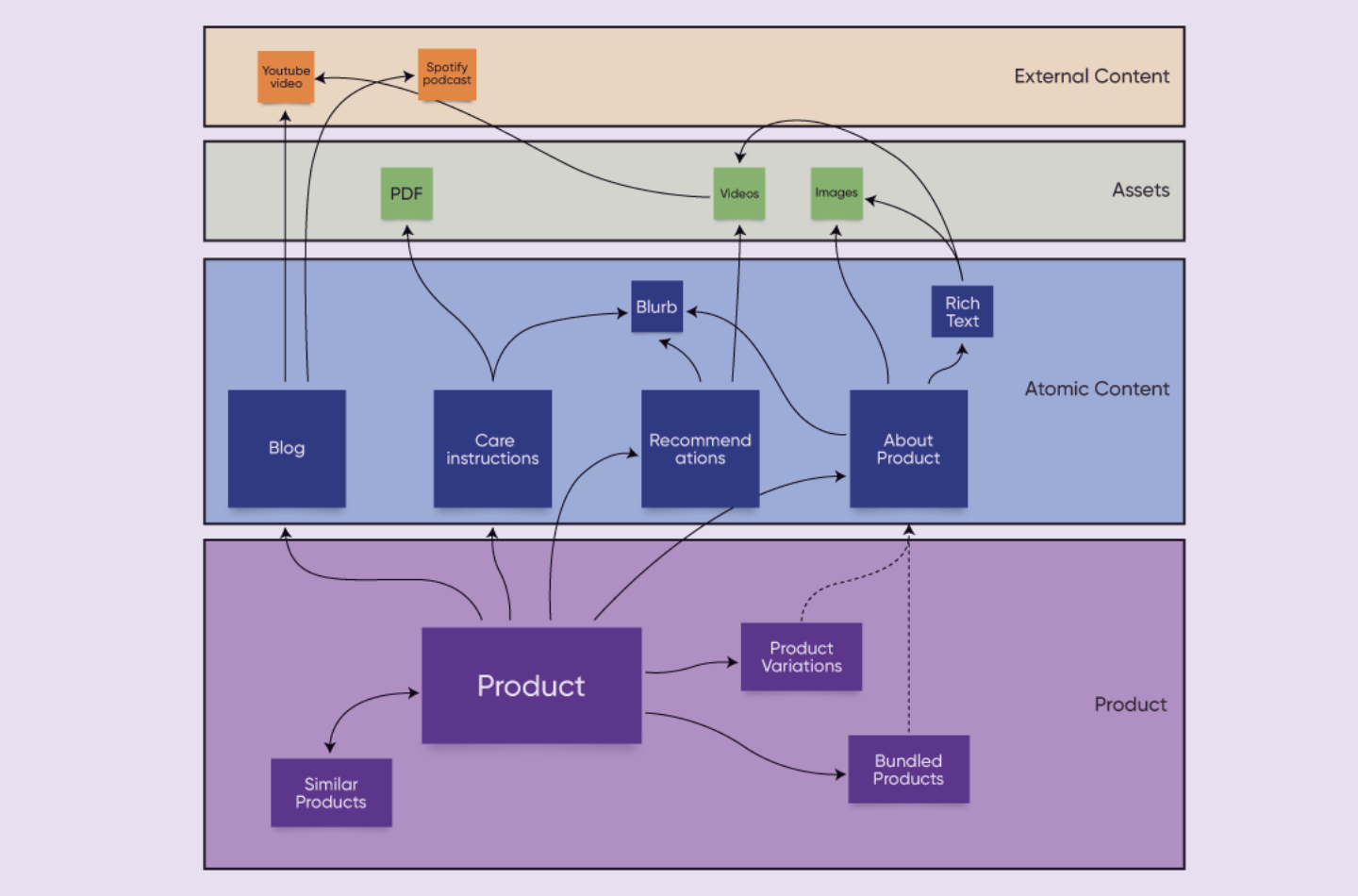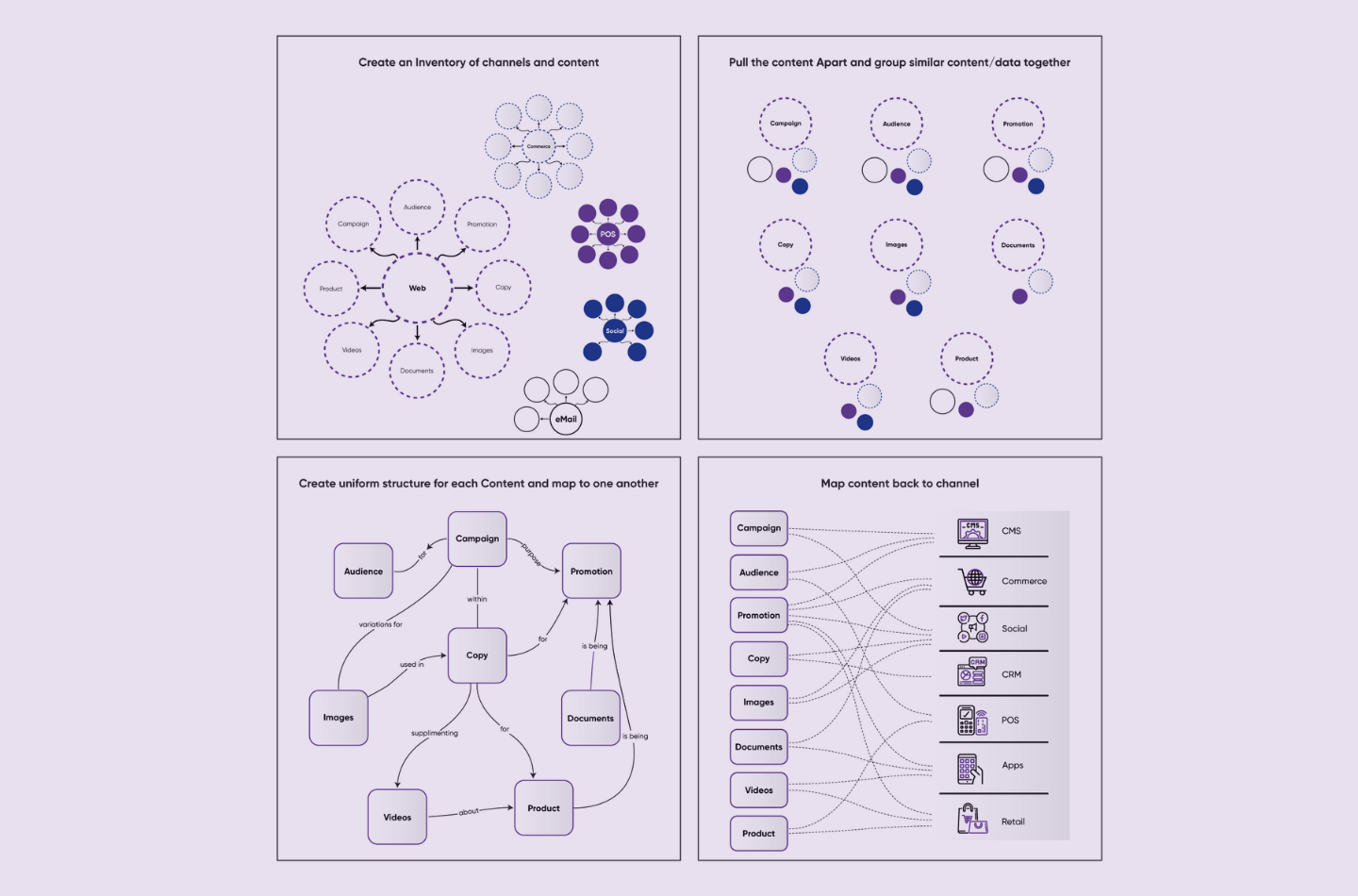
Subscribe
Be the first to know about our latest posts.
-
Service
Partners -
Sub-Service
Sitecore, product engineering, migration and modernization solutions
Explore Icreon’s Ecommerce Services
-
Service
Partners -
Sub-Service
Sitecore, product engineering, migration and modernization solutions
The Content Modeling Framework Every Sitecore Designer Should Know About
Content models provide a standardized way to create, manage, and publish modular content. A Content Modeling framework that works for the organization has become increasingly important for businesses looking to deliver consistent and fast-to-market customer experiences.
In this article, we talk about the approaches to create a content model framework focused on products and on content delivery channels.
Content Modeling Explained
Content modeling is the process of defining and organizing your content. This is a critical step in planning any website or digital experience, as it sets up a structure for the information that will be presented to your users. It's important to spend time thinking about how you want your site to look and feel, as well as how users will interact with it.
Content modeling is the process of creating a hierarchy of topics, subtopics, categories, and tags. Content modeling is also known as taxonomy or ontology.
The Content Modeling Framework (CMF) is a visual tool that helps you organize your information architecture (IA) and develop sites that are more intuitive and easy-to-use. The content model provides a way to organize your IA into logical chunks of information (such as menus and page sections), which makes it easier for designers to build out different areas of the site without worrying about consistency across different pages.
Content Modeling is Important Because
- It helps make sense of your content by organizing it into logical groups. This makes it easier for people to find the information they need on your site, especially if they don’t know exactly what they are looking for.
- It helps search engines understand what the different pages on your site are about so they can return the most relevant results when someone searches for something related to your business or industry.
Why Use a Framework?
If you've ever had to create a new site from scratch or migrate content from one location to another, then you know how challenging it can be. Frameworks are a way to solve a problem. They provide a structure and a set of practices that help you move from your current state to the desired state. Frameworks can be used to improve the quality of your product, reduce costs and increase efficiency. They also help you work smarter, not harder.
A well-developed content model can ease that process considerably by helping you understand what types of information should live on each page and in which order they should appear. It also helps ensure that your pages contain only relevant content with minimal repetition and redundancy.
Content modeling is an important process for many organizations, but it takes time and effort to do well. The goal of this framework is to make the process more efficient and easier to repeat. Its aim is to help you create consistent and reusable content models that can be used across multiple sites.
Content frameworks have also been used by enterprise software vendors to ensure that their products share common concepts and terminology across multiple product lines.
A Content Modeling Process
The Framework begins with research — understanding how your users engage with your brand today and where they go for information when they need it most — then uses that insight as the foundation for creating a high-level page hierarchy . The framework consists of a series of steps that can be used to create a content model for any site or app. The framework can be applied by anyone, regardless of their skillset or background. It's designed to be flexible so that it works with any content structure or layout.
The framework also helps you determine which content types to include on each page, and provides a set of best practices for naming those content types. You can use the Framework as part of your content strategy process or as an independent tool that you employ throughout your site redesign or launch process. Frameworks are not one-size-fits-all solutions. When selecting a framework, make sure it aligns with your goals and objectives.
Remember to Ask the Right Questions:
- Who is creating the content? (Internal Employees, Vendors, Writers, etc.)
- Who is the content being created for? (the audience, personas such as Internal Audience, Vendors, Buyers, Writers, etc.)
- Are various departments within the organization sharing/reusing content? (organizational logos, blogs, articles, etc.)
- Where is the content going to surface? (Delivery/Presentation channels such as Web, Mobile, Social, etc.)
It's important to remember that this is not about the technology, it's about the people who use it. If you are building a site for a company, you need to think about who your users are and what they need from your site.
Product-Focused Content Modeling Framework
The product-focused content modeling framework is based on the idea that the best way to serve customers is to help them make informed decisions about products and services. This requires that your website provides good information about what your products do, how they work, and what benefits they bring to your customers.
In order for this to happen, you need a consistent way of thinking about what types of things are related to each other in the context of your website. This will allow you to organize your content so that it can be easily found by visitors who have a particular need.
Structure Products
At this step it is necessary to model Products first that can then create a base for all the associated content. It contains information about the product, such as its name and price, but also metadata that describes how it's related to other products.
Map to Content
Identify what content is required for various product types and categories across the spectrum of your website. This will help you determine what content should be created and how the different types of content should be organized.
List and Map Assets
Everything starts to link back to products, whether directly or indirectly via content. Ensure that the data is accurate and consistent. This will make it easier for you to organize your content in a way that makes sense for both humans and search engines.
Map to External Channels
Following the structuring, then you can start mapping out how each piece of content should be presented on each channel.
How Does Product-Focused Content Modeling Work?
Product-focused content modeling is a method of organizing your content so that it's easier for customers to find what they're looking for. It's a strategy that can be used in any industry, but it's especially valuable for ecommerce businesses with large catalogs or other products.
Product-focused content modeling works by organizing your content into categories based on features and benefits. Customers are more likely to find what they need when the information is organized in this way because it makes the search process more intuitive. If you have ever tried to shop online, you know how frustrating it can be when you can't easily locate the products and information you want.
This type of content modeling is increasingly important because it helps companies organize their information in ways that are more useful to users. This can mean better search engine rankings, which leads to more traffic and sales.
Channel-Focused Content Modeling Framework
A channel-focused content model is a flexible approach to building a website that allows you to create unique experiences for each type of visitor on your site. You can use it to define the types of content that will be available in each section of your site and how those sections will relate to one another.
A channel-focused content model can help you:
- Define the users who visit your site and their goals for visiting the website
- Identify what information those users need from you.
- Create a structure for organizing that information in ways that help visitors find what they need quickly and easily.
This is an advanced model that requires planning and forethought. However, it can allow you to create a more focused and streamlined experience for each type of visitor on your site.
Create an Inventory
Create an inventory that represents the current state of your site. This will help guide your efforts as you move forward with this model.
Group Content
Separate content from the channel. For example, if you have a blog and a knowledge base, you may want to create two separate groups for those channels. Each group would have its own inventory and relationships with other groups. This will allow you to focus on each channel separately and make sure that they are working well together before going further down this path of creating relationships between content inside each group.
Create Relationships
Create relationships that work for content creators and consumers. When creating these relationships between groups, think about how people use your site today or how they might want to use it in the future.
Map Content Back to Channel
By mapping content back to the appropriate channel, you can ensure that visitors are always taken to the right place. In other words, if they click on a product page in their shopping cart, they will send them back to that same product page in their shopping cart instead of sending them to their website's home page or some other unrelated area.
How Does Channel-Focused Content Modeling Work?
A channel-focused content model involves creating separate page types for each type of visitor who visits your site. For example, one person might visit your home page on their phone while another visits it from their tablet or desktop computer. The two visitors have different needs for information and different expectations about how much time they're willing to spend browsing through links before finding what they're looking for.
When you create a channel-focused content model, you need to determine what information each group needs as well as how you can present that information. This means you need to know what your visitors are looking for and how they use your site. It also means you have to be willing to make tough decisions—like cutting out some content that may already exist on your site but isn’t important enough for the new model.
Creating a Winning Content Hub
Whether it is your ambition to create a content hub tailored to the specific needs of your company or you are being pressed by management to do so, one thing is certain: implementing a content hub will require more time and effort than implementing a Sitecore solution without it. However, if the right amount of planning and preparation is executed in appropriate steps, any Sitecore user can reap the benefits that come with using a well-developed and implemented content hub.
Content Modeling is crucial to the development of any quality website. Because it saves time and ensures that there are no spelling errors, no duplicated content, and so much more. We at Icreon use a design framework which allows us to give web designers a solid base to start from as well as ensuring that templates developed by different web designers work seamlessly together. Learn more about the content modeling approaches and take your UX designing to the next level. Explore Icreon’s Enterprise Ecommerce Solutions.



